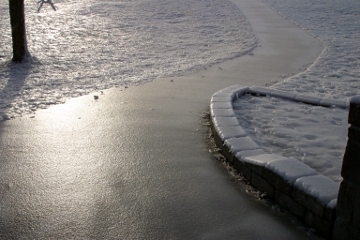- Home
- Loss Control
- Loss Control Insights
- Keep Customers and Employees on Their Feet: 3 Keys for Managing Black Ice
You know that black ice is dangerous. This clear glaze of extra-slippery ice can be found on roads, sidewalks and parking lots creating extra challenges for anyone attempting to walk or drive safely.
When to Watch Out for Black Ice
The thin, slippery layer of ice forms when warmer daytime temperatures melt snow and ice, and then cold overnight temperatures dip low enough to refreeze it.
While black ice can appear any time these temperature patterns are in place, it's most frequent in February and March when increasing daylight and warm days combine to speed up melting of snow piles that have been collecting all winter. This snowmelt spreads across sidewalks and parking lots, freezing overnight and creating a slippery surprise for you to deal with the next day.
Why is Black Ice So Dangerous?
Black ice can appear daily until nighttime temperatures are consistently above freezing. This makes it challenging to keep up with if you're responsible for ensuring safe walking surfaces on your property.
It's also hard to spot, blending in to patches of wet concrete or asphalt. Unsuspecting employees and customers who don't expect to encounter sudden slippery spots are more likely to fall and suffer an injury.
Help keep your people on their feet with these three strategies.
Pile Snow Where it Won't Cause Black Ice
Runoff from melting snow piles is a prime source of dangerous refreeze, so it’s important to collect plowed snow in a location that limits melting onto walkways.
Work with your snow removal contractor to choose a snow pile location that considers factors such as the slope of the property, paths that pedestrians and vehicles usually take and the area’s exposure to the sun (which will increase the rate of snow melt).
If you can, take advantage of drain grates as a way to direct melt water away from travel paths.
Check for Black Ice in the Morning
Because black ice forms overnight, it’s important to check on walkway conditions early in the morning before pedestrian traffic picks up.
If black ice is present, mark the area with cones to alert passersby and treat the walkway with ice melt or traction aids, such as sand or poultry grit.
Make sure employees know which areas are most prone to refreeze so they can check these areas throughout the day, looking for spots that may need additional attention. Make this task easier by placing treatment and snow removal supplies near doorways where employees can quickly grab them.Watch for Black Ice from Roof Runoff
Snowmelt from your roof or gutters can also be a source of black ice if the downspout discharge is directed across walking surfaces. Divert this runoff away from walkways with a downspout extension or a channel that directs the water underneath the walkway.
Find More Online
Get in touch
Need help? We’re here for you! Whether you have questions or need personalized assistance, your local office is ready to support you.
Loss Control Insights
Stay informed with the latest news and receive actionable safety tips, all carefully curated by our team of experts.
